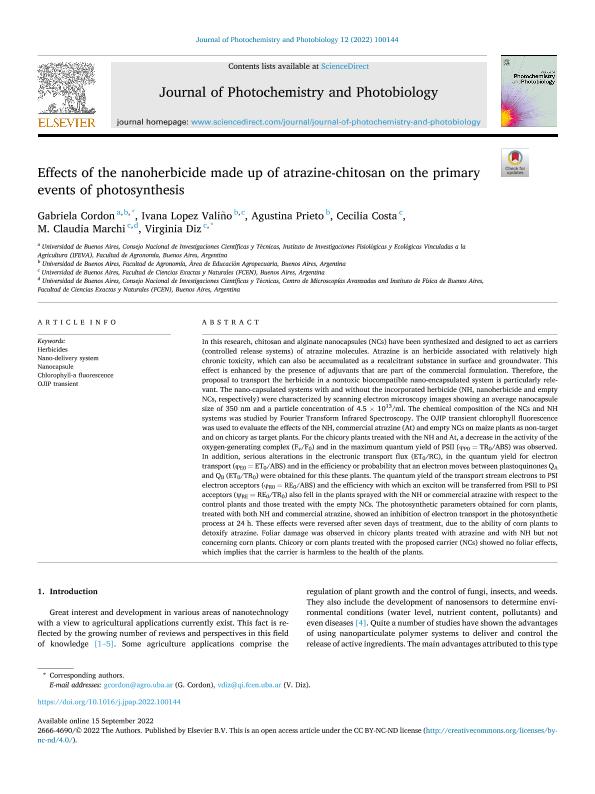Mostrar el registro sencillo del ítem
dc.contributor.author
Cordon, Gabriela Beatriz

dc.contributor.author
Lopez Valiño, Ivana
dc.contributor.author
Prieto, Agustina

dc.contributor.author
Costa, Cecilia Daniela

dc.contributor.author
Marchi, María Claudia

dc.contributor.author
Diz, Virginia Emilse

dc.date.available
2023-08-31T12:00:08Z
dc.date.issued
2022-12
dc.identifier.citation
Cordon, Gabriela Beatriz; Lopez Valiño, Ivana; Prieto, Agustina; Costa, Cecilia Daniela; Marchi, María Claudia; et al.; Effects of the nanoherbicide made up of atrazine-chitosan on the primary events of photosynthesis; Elsevier; Journal of Photochemistry and Photobiology; 12; 12-2022; 1-11
dc.identifier.issn
2666-4690
dc.identifier.uri
http://hdl.handle.net/11336/210020
dc.description.abstract
In this research, chitosan and alginate nanocapsules (NCs) have been synthesized and designed to act as carriers (controlled release systems) of atrazine molecules. Atrazine is an herbicide associated with relatively high chronic toxicity, which can also be accumulated as a recalcitrant substance in surface and groundwater. This effect is enhanced by the presence of adjuvants that are part of the commercial formulation. Therefore, the proposal to transport the herbicide in a nontoxic biocompatible nano-encapsulated system is particularly relevant. The nano-capsulated systems with and without the incorporated herbicide (NH, nanoherbicide and empty NCs, respectively) were characterized by scanning electron microscopy images showing an average nanocapsule size of 350 nm and a particle concentration of 4.5 × 1013/ml. The chemical composition of the NCs and NH systems was studied by Fourier Transform Infrared Spectroscopy. The OJIP transient chlorophyll fluorescence was used to evaluate the effects of the NH, commercial atrazine (At) and empty NCs on maize plants as non-target and on chicory as target plants. For the chicory plants treated with the NH and At, a decrease in the activity of the oxygen-generating complex (Fv/F0) and in the maximum quantum yield of PSII (φP0 = TR0/ABS) was observed. In addition, serious alterations in the electronic transport flux (ET0/RC), in the quantum yield for electron transport (φE0 = ET0/ABS) and in the efficiency or probability that an electron moves between plastoquinones QA and QB (ET0/TR0) were obtained for this these plants. The quantum yield of the transport stream electrons to PSI electron acceptors (φR0 = RE0/ABS) and the efficiency with which an exciton will be transferred from PSII to PSI acceptors (ψRE = RE0/TR0) also fell in the plants sprayed with the NH or commercial atrazine with respect to the control plants and those treated with the empty NCs. The photosynthetic parameters obtained for corn plants, treated with both NH and commercial atrazine, showed an inhibition of electron transport in the photosynthetic process at 24 h. These effects were reversed after seven days of treatment, due to the ability of corn plants to detoxify atrazine. Foliar damage was observed in chicory plants treated with atrazine and with NH but not concerning corn plants. Chicory or corn plants treated with the proposed carrier (NCs) showed no foliar effects, which implies that the carrier is harmless to the health of the plants.
dc.format
application/pdf
dc.language.iso
eng
dc.publisher
Elsevier

dc.rights
info:eu-repo/semantics/openAccess
dc.rights.uri
https://creativecommons.org/licenses/by-nc-nd/2.5/ar/
dc.subject
CHLOROPHYLL-A FLUORESCENCE
dc.subject
HERBICIDES
dc.subject
NANO-DELIVERY SYSTEM
dc.subject
NANOCAPSULE
dc.subject
OJIP TRANSIENT
dc.subject.classification
Otras Ciencias Químicas

dc.subject.classification
Ciencias Químicas

dc.subject.classification
CIENCIAS NATURALES Y EXACTAS

dc.title
Effects of the nanoherbicide made up of atrazine-chitosan on the primary events of photosynthesis
dc.type
info:eu-repo/semantics/article
dc.type
info:ar-repo/semantics/artículo
dc.type
info:eu-repo/semantics/publishedVersion
dc.date.updated
2023-07-07T22:18:21Z
dc.journal.volume
12
dc.journal.pagination
1-11
dc.journal.pais
Países Bajos

dc.journal.ciudad
Amsterdam
dc.description.fil
Fil: Cordon, Gabriela Beatriz. Consejo Nacional de Investigaciones Científicas y Técnicas. Oficina de Coordinación Administrativa Parque Centenario. Instituto de Investigaciones Fisiológicas y Ecológicas Vinculadas a la Agricultura. Universidad de Buenos Aires. Facultad de Agronomía. Instituto de Investigaciones Fisiológicas y Ecológicas Vinculadas a la Agricultura; Argentina
dc.description.fil
Fil: Lopez Valiño, Ivana. Universidad de Buenos Aires. Facultad de Agronomía; Argentina
dc.description.fil
Fil: Prieto, Agustina. Universidad de Buenos Aires. Facultad de Agronomía; Argentina
dc.description.fil
Fil: Costa, Cecilia Daniela. Universidad de Buenos Aires. Facultad de Ciencias Exactas y Naturales; Argentina. Consejo Nacional de Investigaciones Científicas y Técnicas; Argentina
dc.description.fil
Fil: Marchi, María Claudia. Universidad de Buenos Aires. Facultad de Ciencias Exactas y Naturales. Centro de Microscopías Avanzadas; Argentina. Consejo Nacional de Investigaciones Científicas y Técnicas. Oficina de Coordinación Administrativa Ciudad Universitaria. Instituto de Física de Buenos Aires. Universidad de Buenos Aires. Facultad de Ciencias Exactas y Naturales. Instituto de Física de Buenos Aires; Argentina
dc.description.fil
Fil: Diz, Virginia Emilse. Universidad de Buenos Aires. Facultad de Ciencias Exactas y Naturales; Argentina
dc.journal.title
Journal of Photochemistry and Photobiology
dc.relation.alternativeid
info:eu-repo/semantics/altIdentifier/url/https://linkinghub.elsevier.com/retrieve/pii/S2666469022000379
dc.relation.alternativeid
info:eu-repo/semantics/altIdentifier/doi/http://dx.doi.org/10.1016/j.jpap.2022.100144
Archivos asociados
